By 2026, eLearning market size is projected to reach $167,5 billion, so there is no surprise that online learning solutions are on the rise now. eLearning is a promising niche for starups that opens up a lot of revenue-driving opporuntites, so if you’re an entrepreneur and want to create an e-learning platform, we’re here to help. This guide will walk you through the process of getting your platform off the ground and keeping it running smoothly.
Types of eLearning Platforms
Before discovering how to build an online learning platform and what type of software to choose for your business, let’s quickly discover a brief definition. An e-learning platform is a digital space where students can access courses and resources that are relevant to their studying needs and goals. Since these needs and goals can be pretty diverse, there are several types of eLearning solutions that can be classified in several ways.
Types of eLearning platforms depending on the functionality:
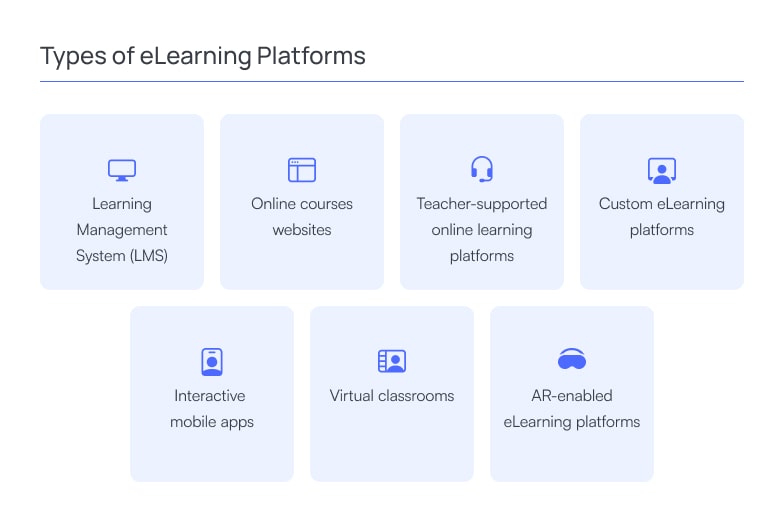
- Learning Management System (LMS). LMS systems are the solutions frequently used by schools, colleagues and univiresities for class schedule planning, attendance control, teachers’ workload planning, and student’s success tracking.
- Online courses websites. We bet you know this type of eLEarning software well – Udemy and Coursera, for example, needs no introduction. These are the platforms that consolidate online courses from different areas so that everyone can study them for free or for a fee.
- Teacher-supported online learning platforms. With the help of these eLearning applications, students can study with teacher’s support. These platforms often take form of a marketplace where a student can hire an online teacher, depending on the topic they would like to study, the cost per class, teacher’s availability and rating.
- Custom eLearning platforms. There are also custom eLearning platforms that are usually tailored to a certain business. For example, HubSpot, an all-in-one marketing software provider, has created HubSpot Academy – a platform that shares introductory marketing video courses for free.
- Interactive mobile apps. eLearning mobile applications usually come with gamification features. The learning materials are structured in such a way that the user can study in short iterations and right on the go. For example, DuoLingo allows for studying a foreign language using a game-like mobile app.
- Virtual classrooms. This type of eLearning software makes the most sense for remote or hybrid learning in groups. With its help, a group of students can interact with a teacher during a lesson, send homework assignments, and receive feedback within a single platform.
- AR-enabled eLearning platforms. These are the most sophisticated eLearning solutions that are usually used for employee training. For example, with the help of Augmented Reality technology, it becomes possible to create a virtual environment to let employees develop critical skills safely.
Types of eLearning platforms depending on the target users:
- For students. These platforms are designed to be used in the classroom, and they can be used by teachers or students. They can include a variety of features, including content management systems, learning management systems, automated testing and reporting tools, and more.
- For employees. eLearning solutions for employees are designed to help them learn on the job. These apps often feature training resources or courses related to the company’s goals.
- For anyone. With this eLearning software, everyone can learn anything from anywhere at any time. For example, Khan Academy and Coursera allow users to take free or paid online courses from prestigious universities around the world.
In addition, there are also self-hosted and SaaS (software-as-a-service) eLearning platforms. The companies that develop eLEarning solutions for their internal goals (for example, employee training) usually host them on their own servers, while in the case of SaaS, anyone who paid a subscription fee can access the learning materials. In our recent article, we have also explained how to create a SaaS platform, and you are welcome to check it out as well.
The Benefits of Creating an Online Learning Platform on Your Own
Still doubt whether you have to create your own eLearning platform in 2023? Discover the main business benefits to do it.
- Tap into a trending industry. The online learning industry is booming. And with the rise of new technologies, there are more opportunities than ever to create new edTech startups that modern learners will love.
- Create a recurring revenue stream. Not only will you be able to tap into a trending industry, but you’ll also be able to create a recurring revenue stream off of your customers’ subscriptions and memberships. Plus, creating your own eLearning platform is an opportunity to drive revenue in the long run – the popularity of eLearning and mobile learning solutions will only increase in the future.
- Leverage free learning materials to attract customers to your brand. With so many people looking for free learning options, why not use them as an opportunity to attract new customers? This is just what HubSpot does. The company helps its prospects learn the basics of digital marketing, builds their loyalty in this way, and then, sells its software subscription packages.
Ready to get these benefits for your business? Meet our business analysts and software developers today!
Contact usHow eLearning Platforms Make Money?

There are three ways to monetize your eLearning platform.
- Subscription. Subscription is a common monetization strategy for eLearning platforms. It allows the users to pay a fee for accessing all courses available on the platform. This article also makes sense for language-learning applications since this process is likely to take up to several years.
- Course-based payment. In this model, the users pay for each course separately, for example, like on Coursera. They can choose from a variety of courses on the platform and purchase only those that are relevant to their needs. As usual, promo codes and discounts encourage users to buy more courses faster.
- Advertising. This is one of the most popular ways of making money online. It involves placing ads on the platform in order to generate revenue from them. However, be careful with this monetization strategy. Place highly-relevant ads only, and make sure they don’t annoy the learners.
Essential Features of an eLearning Platform
Before you create your own eLearning website, decide on the feature set you have to develop for each of the user groups.
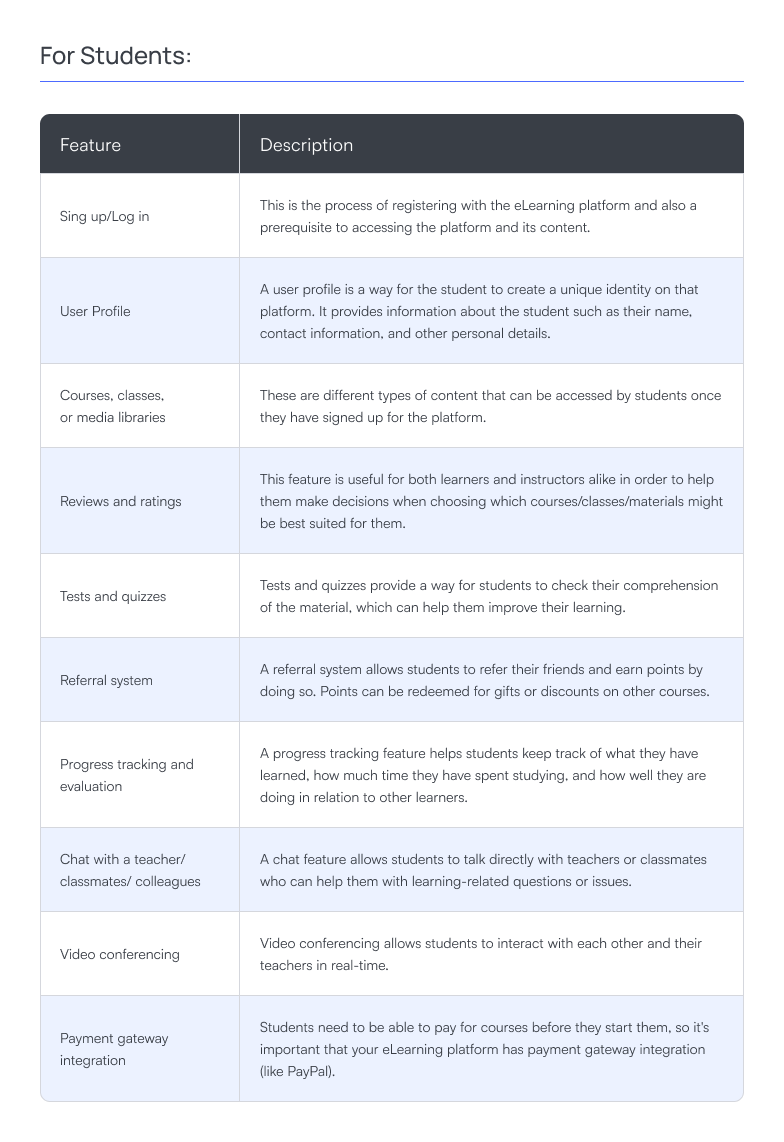
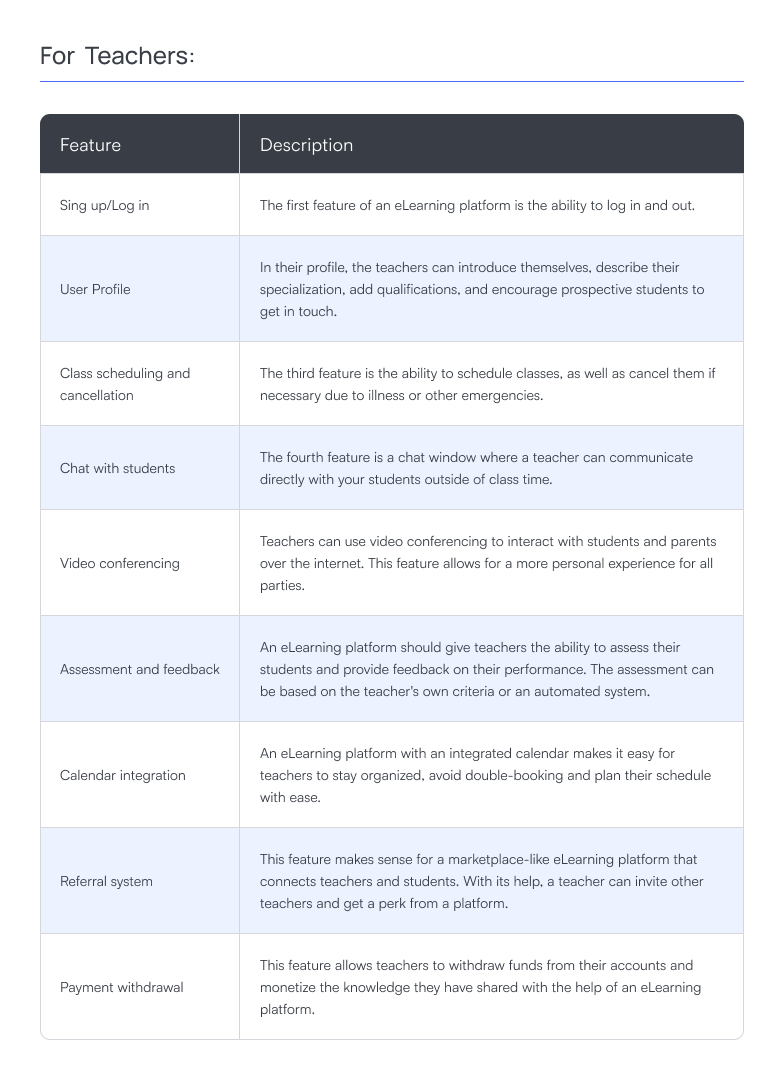
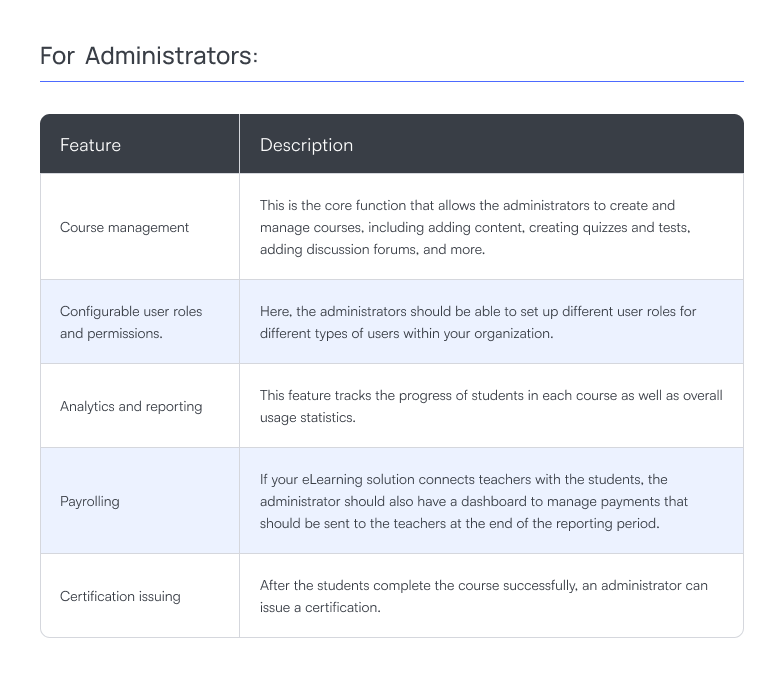
How to Create an Online Learning Platform – Step-by-Step Tactic for 2023
Now, let’s find out how to build an eLearning platform stage-by-stage, following the latest development practices and battle-proven approaches of Agile methodology.
Stage 1 – Discovery
The first stage is all about discovery. This is where you’ll get a good idea of the needs of your target audience, as well as what’s already out there in terms of similar products or services. So, think about what you’re trying to accomplish and why it’s important. What are the problems that need to be solved? What are the benefits of your product or service? Who is your target audience? What are their needs, desires, and goals?
Stage 2 – Software Requirements Specification
After you have found clear answers to the questions above, you need to write a document that describes how your app should work. This document is called Software Requirements Specification (SRS) and it will be used by software engineers to implement the features described in it. It will also help you communicate with developers about what features are required so that you can make sure they don’t miss anything important.
Stage 3 – Prototype and design
The prototype stage is where you have to start building your online learning platform. This stage begins with an initial design of your site, followed by a functional prototype that will give you a sense of how the final product will function. The main goal of this stage is to create a wireframe (or mockup) of what the site will look like, including both the visual design elements as well as the functionality and interaction.
Stage 4 – UI/UX testing
Once the prototype is ready, it is necessary to test it with real users and get feedback on whether they understand how to use the app and if they’re able to complete tasks successfully. If there are any issues with either usability or functionality, you have to make the corresponding adjustments and test a prototype again until everyone is happy with the results.
Stage 5 – Coding and development
Coding is the process of translating a business idea into a functioning software program. It involves writing code using programming languages like HTML, CSS, and JavaScript if you build a web-based solution. At this stage, it is better to have a team of software developers who specialize in front- and back-end development, are skilled with either web or mobile development technologies, and have a deep understanding of both your business processes and eLearning niche specifics.
Stage 6 – Testing and bug fixing
Once your developers have coded your platform, it’s time to test it before launch. Ensure that all of the features are working correctly and then, fix any bugs that may have been missed during the coding process. This step is crucial because it allows you to identify any errors before launching the platform and avoid those embarrassing moments when users report issues with certain aspects of the platform.
Stage 7 – Launch and post-production support
Once everything is ready to go live, you need to make sure that your platform is running smoothly and providing a great experience for users—and this is where post-production support comes in. We, at Binerals, are ready to support you at each development stage, sharing our expertise and suggesting pitfalls-free ways to make your eLearning project idea happen.
The Cost to Develop an eLearning Platform
As with any other software, the eLearning platform development cost depends on the complexity of the solution you would like to create, the number of features you have to build, the complexity of the design, and the location of your development team. In the chart above, we provide an approximate breakdown of the cost to create an online learning platform in Ukraine, hiring a software development team at a rate of $50 per hour.
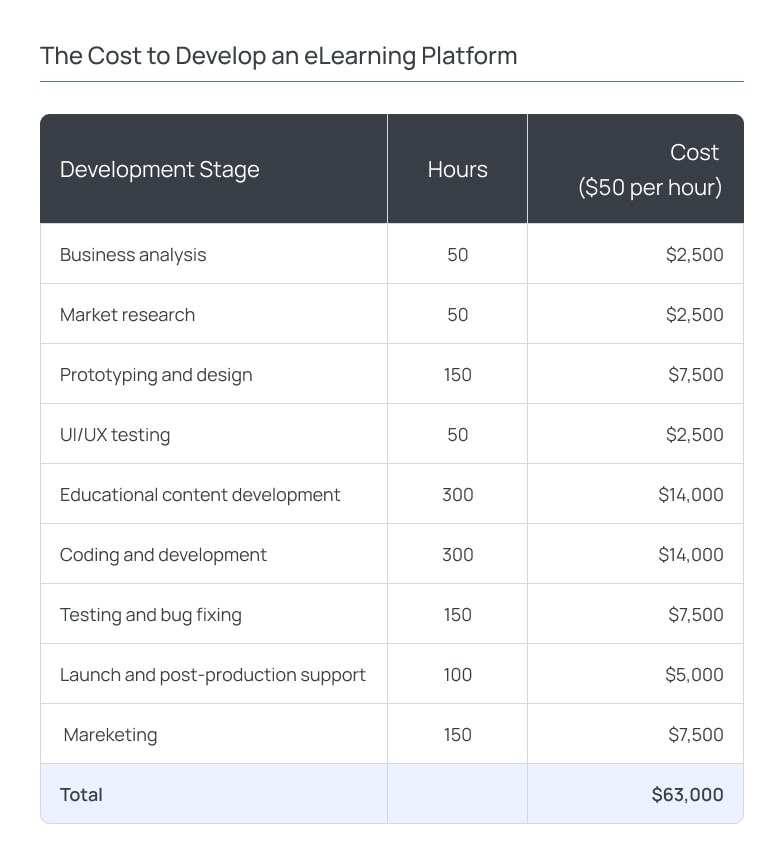
So, the cost to develop an eLearning platform is approximately $63,000 for an MVP version of a future solution. When planning your development budget, keep in mind that the final price tag to create an eLearning website or mobile app also depend on the software type and the technologies you use to develop it. Contact our tech team now for an initial consultation to get a better idea of how much your future eLearning app may cost.
Conclusion
eLearning is a very promising business niche, as it’s growing rapidly every year. The number of eLearning platforms is growing as well, making the competition more fierce. The only way to stand out from the crowd is to create an online learning solution of exceptional quality, tailoring its features to your target learners’ needs.
However, if you are an entrepreneur with little to no technical background, creating an eLearning platform from scratch will be a serious challenge. Here is where Binerals’ team can help by sharing our tech expertise and the best eLearning development practices. We have extensive experience in building enterprise-level solutions for edTech and eLearning niches. Our dedicated developers would also be happy to meet you right now and discuss your project.
FAQ
How to find an idea for eLearning platform development?
You can find an idea for eLearning platform development in a variety of places. You can look at the market, and see what kind of products and services are already available, and how they compare to your own. You can also look at the industry you’re targeting, and figure out what needs there might be that aren’t currently being met by existing products and services.
Why is building your own eLearning website promising?
There are several reasons why creating your own eLearning platform is a promising idea for both startups and mature companies. While the first can easily tap into the trendy industry with an innovative product, big organizations are welcome to give their employees a better way to train and/or attract new customers with high-quality educational content.
What technology to choose for creating an eLearning app?
The choice of technology to build an eLearning solution largely depends on its type. For example, if you want to build an app for learning a foreign language, developing a mobile app makes the most sense. With it, the users will be able to learn on the go and in short iterations. More sophisticated solutions like LMS, virtual classrooms, or online course marketplaces are better to build on web technologies. Get in touch with our tech experts to discuss your idea and shortlist the most effective tools for your online learning platform development.
How to gather a tech team to build an eLearning platform?
You can either build an in-house team on your own or hire freelance developers but opting for a dedicated development team is a smarter approach. In this case, you don’t have to worry about managing or training them; dedicated programmers already know how and what to do. Plus, they’re experts in their field, so they’ll be able to help you make decisions that will save you time and money down the road.
How much does it cost to create an eLearning app MVP?
Creating an MVP for your eLearning app can be a big investment. Depending on what your app does, it may cost anywhere from $10,000 to $200,000. If you’re just testing out some ideas and don’t need anything too fancy, you might be able to get away with something simpler (and cheaper). In this case, you might only need to create a prototype or wireframe to test how people react to a certain type of interface.
But if you want to create something to impress potential users and investors, get ready for making a significant investment in advance. The location of your development team also matters for the cost to build an eLearning website. That’s why we kidnly recommend hiring highly-qualified Ukrainian programmers at a competitive cost.
